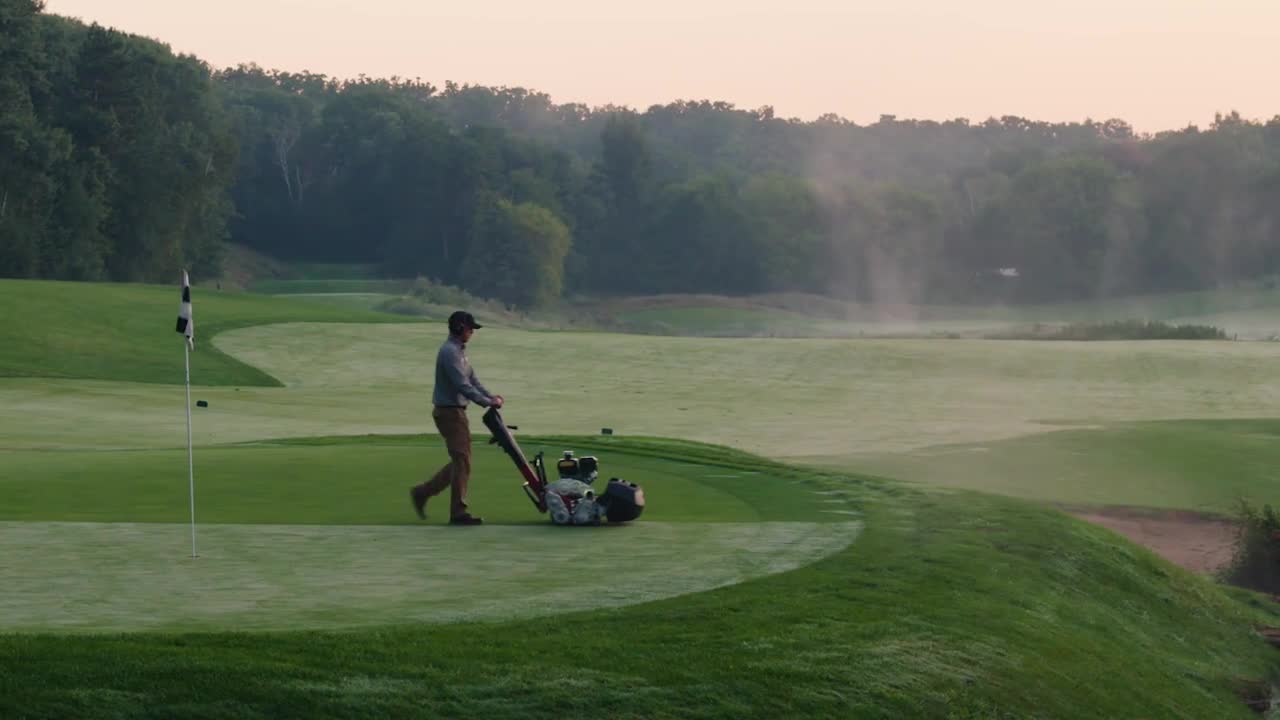Get Your Irrigation System Ready for Winter
It’s a simple fact: Water expands when it freezes. And when temperatures drop, that can spell trouble for an irrigation system that hasn’t been properly winterized. The good news is that you can take precautions to prevent damage and extend the life of your system components.
Following is a brief overview of the winterization process for golf. For more detailed information, please contact your Toro distributor to obtain a copy of the detailed guide (publication number 373-0849).
When to Winterize
The decision to winterize depends on the part of the country you’re in and how you use your irrigation system. The general rule of thumb is that it’s time to winterize when you have three or more days at three degrees below freezing (32˚F / 0˚C). That’s when water begins to freeze deeper in the ground where the laterals are typically buried. If you expect an extended period of freezing temperatures, evacuate your system. However, if you’re in a region where you need to irrigate during the fall or winter months, winterizing may not be required.
Three-Step Process
Winterizing, or decommissioning, an irrigation system may vary from region to region, but the principles are the same. There are typically three essential steps:
- Turn off the water and electricity. First, make sure the water is turned off so there’s no source pressure in the system. If you have a pump or other electrical components, it’s also important to turn off the electrical supply so that nothing can be accidentally turned on during the off-season.
If you need the electricity to keep running a gate or water feature, or to actuate valve controls in an automatic system, you can just connect the wires from the controller to keep key functions running, or you can use a handheld commercial actuator to actuate solenoids one by one.
- Drain water from the system. You can empty the system out either by gravity or by using a pressure source (usually air). For every single lateral, make sure that you install a drain valve at the lowest point — where it’s deepest in the ground or at the lowest point on a slope. Plastic or brass drain valves are inexpensive and easy to install. Just glue in an upside-down T, thread it in the drain valve down into the ground, and put about 6 to 8 inches of gravel around it for drainage. In some climates, this makes it possible to operate and drain the system multiple times until the temperature drops for an extended period of time.
- Actuate golf sprinklers and block zone valves. Actuate or manually bleed the water from anything that is connected to the source, including check valves, double check valves, solenoids, atmospheric or pressure vacuum breakers, and reduced-pressure actuators. Water often becomes trapped in the valve above the diaphragm and in the solenoid ports, so it’s important to evacuate them to avoid freezing and damaging the rubber tip on the plunger.
Toro recommends actuating golf components only once. Repeated activations with no water in the sprinklers can cause damage. The system doesn’t need to be bone-dry.
Tips for Using Pneumatic Pressure
If you’re using a pneumatic pressure source to empty your system, keep the air pressure below 50 psi to gradually open the lines and slowly displace water. During winterization, compressed air travels through the piping system at a much higher velocity than water, and trapped water pockets that break loose during winterization can move quickly through the pipe, causing damage to whatever it hits along the way, including pipe, fittings, sprinklers and valves. Gravity draining is an extremely effective alternative, and can significantly reduce major damage to the sprinkler.
If your system has the above features, before you use the compressed air, first allow the system to drain naturally several days by opening low point drains and venting high points. Additionally, attaching the compressor to the highest point possible and using compressed air to force remaining water out of the low points is the most effective way to blow out the system. When working from high points to low points, you will want to blow out the lines until the expelled air looks clear.
How Long Does It Take?
The time needed to winterize depends on the scale of the property. As a general guide, it can take several hours per zone to complete all the steps and check the heads for golf courses with a 6-, 8- or 10-head fairway system. Also keep in mind that the time increases at a 4-to-1 ratio when you scale up. That means if the pipes are twice as big and the heads are twice as big, it’s going to take four times longer.
Fall Is Also the Time for Maintenance
When you’re short on staff and even shorter on time, maintenance can take a backseat to other priorities. But that doesn’t mean it’s not important to take care of the equipment you’ll be shutting down for the winter. After you have evacuated the system, opened all the drain plugs and drained the lines, it’s a good idea to disassemble and clean large commercial sprinklers and nozzles. That’s especially true if you blow out the system with pressurized air hoses, because any debris can be blown to the end of the line. Toro also recommends lubricating O-rings and other components as required before reassembly.
If a thorough cleaning isn’t possible, there are other options. You don’t have to service every sprinkler on the lateral, but take the time to clean out the last one and blow out the line. Water isn’t the only thing that flows to the lowest point, which means drain valves can also become clogged with debris.
Maintenance can be done in the spring, but performing it in the fall is preferable because, in most areas, the ground doesn’t just freeze once and stay frozen. It typically thaws and refreezes over and over again, which can put significant stress on O-rings and other rubber components if they are not properly lubricated. In addition, spring tends to be a busier time for many golf courses. If the activity at your facility slows down in late fall, you may have more time to perform thorough system maintenance.
Winterizing Now Saves Headaches Later
At Toro, we have a saying: What you don’t do in the fall will likely come back to haunt you in the spring. Frozen pipes can break, resulting in costly repairs. Freezing and thawing can also cause damage to more delicate parts, such as valves, diaphragms and pressure vacuum breakers. In the worst-case scenario, if you don’t drain the system and it freezes, you could see damage at the point of connection or valve manifold. You could even end up having to dig and replace the lines and sprinklers.
A little winterization and maintenance can go a long way to protect your irrigation system. Plus, any effort you put in now will likely make it easier to get your system up and running in the spring with fewer problems.





